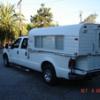Now I'm trying to diagnose and repair a nagging electrical issue.
Problem: when I plug an extension cord into the 110v external socket, the house circuit trips the breaker (GFI) or blows a fuse.
What I have done so far:
- checked out the wiring at the external socket and it's good, no shorts.
- checked the wiring and connections at the single breaker box, and I can't figure out if things are where they should be (I'm not an electrician nor do I have a proper wiring diagram for that box). So I disconnected the wires coming in and going out
- I've ascertained that there is continuity and no shorts between external socket and the input to the breaker box
- checked the wiring and connections at the two cone lamps in the back, and it looked generally good (redid some connections for good measure); good continuity with the 3 wires coming out of the breaker box (Hot/black, Neutral/While, Ground/bare).
- checked the wiring and connections at the combination overhead lamp over the sink: the 110v socket looked like it had been replaced, and the Hot and Neutral wires were reversed on the socket connectors, not sure that is an issue, so put them on the right connectors; ascertained good continuity with the 3 wires coming out of the breaker box
- checked the wiring and connections at the single inside wall socket (behind the fridge): ascertained connectivity with Hot and Neutral, but Ground looked a little wonky (not full continuity with ground wire exiting the breaker box); replaced the double socket because it looked cracked; once in place, lost the ground continuity; took the wires off and rechecked continuity and the ground is now open.
So: do I have a problem with an open ground at that inside double 110v socket? How do I diagnose further since the wire running to it is hidden by the woodwork?
Is there something else I should do to further troubleshoot?
Does someone have instructions on how to wire the breaker in that box, in case it was improperly wired before I disconnected everything? Here's a pic of my box, both white wires go to same terminal. The wires on left are connected to external 110v socket on the camper, the ones on the right go to the light and plug circuits in the camper.

Have any of you rewired parts of your Alaskans and how much of a job is it?
[I HATE electrical problems and gremlins...]
And after the 110v circuit is sorted out, I still need to figure out how to setup an adequate 12v system to feed the 12v lamps, the new Fantastic Fan I installed, etc...
Thanks for your help and advice.
--Robert
p.s. oh yeah, also will be ordering tie-downs so I can finally mount it and secure it to my 96 Dodge 4x4. Hopefully I'll have it all running and installed for an initial camping trip this summer... Here's a picture of my truck beside the raised camper, to give an idea of what it will look like when it's on the truck.


















